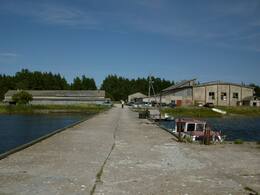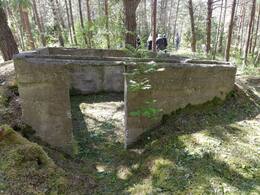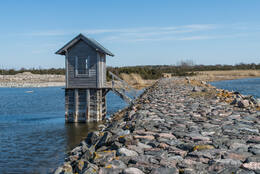Sarema ir Hyjuma - Estijos jūros sienos forpostas
Diena 2.
185 km
Sõrve–Panga–ferry to Hiiumaa–Sõru–Orjaku
Praktinė informacija
- Driving distance: ~185 km
- Due to distances and time, 3–4 of the listed sights can be visited on this day.
- It is recommended to book the ferry tickets in advance. Bookings and timetables veeteed.com.
- In Hiiumaa it is recommended to use the guide services from Hiiumaa Military Museum info@militaarmuuseum.ee.
Lankytinos vietos
Papissaare Seaplane Base
This seaplane harbour is situated on Papissaare Peninsula, to which an historic cobbled road leads from the small borough of Kihelkonna.
Papissaare Seaplane Base, which formed part of Peter the Great's Naval Fortress, was established between 1912 and 1914. It comprised two aircraft hangars, equipment and ammunition warehouses, a fuel tank, an electric generator, barracks, a canteen, a bread factory and a bathhouse. In August 1914, nine aircraft were brought here from Liepāja. On 12 October 1917 German forces captured the base and destroyed most of the buildings. During the interwar era the complex was the site of Julius Teär's Shipyard.
On 24 October 1939, Soviet forces acquired the complex under the Mutual Assistance Pact and restored it as a seaplane harbour. The MBR-2 seaplanes of the 15th Aviation Squadron stationed here fought in the Finnish Winter War. In late summer 1941, German bombers obliterated the seaplanes. The Soviet squadron abandoned the base, setting it on fire as they did so. From 1940-1960 the whole peninsula was a restricted military zone. Later, the complex was used by the local fishing collective. Today the remaining buildings are in use as workshops and warehouses.
This historic seaplane harbour has become an important tourism port, providing passage to the unique island of Vilsandi.
Pangos karinis takas
This military hiking trail is situated on the north coast of Saaremaa, 1.5 km north-west of the village of Panga. The most convenient access to Panga is via Võhma.
The trail is situated along Panga Bank, which is the highest bank of exposed bedrock anywhere in Western Estonia and on the islands. Its length and openness to the sea are what make the bank special in terms of terrain and attractive to tourists. It is situated in Panga Nature Park, surrounded by the Baltic Sea to the north and north-east, by the mouth of Küdema Bay (an important bird site) to the west and by forests to the south and east.
Panga Bank did not see any active combat. The area was used for defence purposes, as it was a restricted access zone on the border of the Soviet Union.
The sundial marks the place where a searchlight once stood, guarding the national border.
Today the 2 km long military hiking trail passes by the ruins of a variety of military facilities.
Hindu (Seru) 120 mm pakrantės apsaugos baterija Nr. 34
The construction of the battery began in 1914. As it was an additional battery, missing in the original plan of the naval fortress and the type of guns was repeatedly changed. Finally four 120- mm Vickers guns were installed. A 200-m length and 10-20-m width sandbar was piled up in defence of the gun emplacements and covered in concrete above the guns. Hindu was the only battery in Hiiumaa that participated in combat operations during the Tagalahe landing on 12 October 1917. After a brief exchange of fire with the German warships the Russian artillerymen fled, leaving the battery intact. The Germans sent a landing unit of soldiers inland that blew up the guns of the battery. One of the German warships that shot Hindu battery, was ’Bayern’, the warship with the largest displacement that has ever been in the Estonian waters (length 180 m, displacement 32 200 tons, eight 380-mm guns).The building of the battery radio station was transported to Emmaste and was used as the community centre (demolished in the 1980s). The gun barrels and other larger details were still there in 1937. Today the first and the second gun platforms are still identifiable, the other two are situated on a fenced farmyard. The third gun crater is filled with earth and there is a newly built house facing the sea, the remains of the fourth one is merely a cracked concrete platform. Out of two air defence gun platforms, one survives (a hundred metres toward the nursing home, on the right side of the road). There are no intact buildings. The machine gun bunker between the first and the second emplacement was completed in 1941.
Concurrently with the construction of Hindu battery, there was a plan to build something in Lepiku village where large gravel bars were piled up, still visible today. It is unknown what the building was going to be.
Tohvri (Hindu) 130 mm pakrantės apsaugos baterija Nr. 44
A building battalion of the Red Army arrived in Hindu village in October 1939. The local population was ordered to leave their homes before winter. By the following spring the battery area was surrounded by a wire fence. Building material arrived via Sõru Port where work was done in 3 shifts, 24 hours a day. At least a hundred local men were employed to build the battery. Concrete mix was manually made in large tubs, foundation holes were dug. The barracks were going to have two storeys, the second storey angle iron framework was completed when the top committee came to check on the construction. An order was given to demolish the second floor because it was visible from the sea. By the autumn of 1940 two barracks, two officers’ residential buildings, a canteen, two saunas, a food cellar, two firefighting water reservoirs and a gate guard post were completed. A large-scale construction was to continue and there were a couple of thousands of tons of cement in the depots.
The crew of the battery included 5 officers and 125 lower rank soldiers. The test firing of guns took place in summer 1941 when boat-like vessels with masts towed by tugboats on long wire ropes appeared. The battery was never fully completed, some of the shelters and the water reservoir are not covered with earth. The armoured doors were probably never fully installed. Just the concrete floor of the gas shelter (shelter-power station) with its spiky reinforcement iron bars got completed. One gun and its crew were taken to Heltermaa in September 1941. During the German landing in October an ammunition shelter together with the rest of the battery’s ammunition were blown up. The powerful explosion ripped and scattered the walls of the explosive charge room and raised its roof into the air which broke in two after falling on the standing wall.
The other three gun blocks have survived more or less intact and dry. Recently, the area has been cleared and the positions can be fairly easily identified. The command post is half filled with water the whole year round. Due to its wet location the ferroconcrete and bricks are in a notably worse condition than in Tahkuna.
Around the battery there are five machine gun bunkers, each of a different construction. A couple of hundred metres to the Northwest of the battery position there is a small open observation post. There are two machine gun bunkers by the base as well. Near the upper lighthouse of Sõru there are the ruins of a machine gun bunker with a shooting sector of laid bricks. At least 15 such weapon pits were built between Tärkma and Õngu in 1941.
In 1944–1945 the battery was reconstructed with three 130-mm guns. The last training shots were taken on 23.09.1957. The following March the guns were taken away and then the battery was closed down. Today the former base accommodates Tohvri nursing home.
Orjaku karinis uostas
Orjaku harbour was intended to be used as an Imperial Russian Navy base for torpedo boats. Construction began in 1912, only to grind to an indefinite halt following the outbreak of World War I. Just two breakwaters had been completed by this point, which encompass the harbour to this day. During the final years before the Soviet occupation, a channel 4 metres deep, 35 metres wide and 2.2 km long was dredged.
Vietos pavalgyti
Pub at Orjaku Port
Grillhouse "Lest ja Lammas"
The goal of Grillhouse "Lest ja Lammas" is to serve food typical of the Hiiu island by mainly using produce grown, produced, and available in Hiiu County and Kassari. Younger guests can choose from a children's menu and have fun in a playroom.
Local fish, mutton, apple juice, honey, jams, and herbal teas are only a part of the products which are prepared on the spot and which you can buy to take home with you.
Vetsi Talli Holiday Village
Vetsi Talli Holiday Village is famous for its beautiful apple orchard and accommodation close to nature.
You can stay overnight in a garden house, a barrel cabin, or an apartment. Enjoy the hot steam in two wood-fired saunas and prepare a light meal in the shared kitchen. There are places for caravans, and pets are also welcome!
During the summer, you can enjoy the best local flavors and refreshing drinks at Vetsi Talli Tavern.
At Vetsi Talli Holiday Village, you can relax any way you want! Come alone and enjoy the peace and quiet, spend romantic time with a partner, plan a fun family holiday, or invite a larger group and organize unforgettable summer days here.
In Hiiumaa hiiumaale.ee
Vietos apsistoti
Dagen Haus Guesthouse
The guesthouse is located at 100 m from the protected Orjaku 'eye' (inland gulf). It has been attempted to convey the spaciousness and serenity to all the second-floor bedrooms. Ceilings, fitted with wide beams, fragments of old floors, mixed and matched with glass walls and metal structures.
Kassariotsa Holiday House
The Holiday House can be used throughout the year and has comfortable bedrooms, a fireplace room, comfortable furniture, a TV, a kitchenette, a sauna, a terrace, and an outdoor grill.
In addition to the main building, there is a sauna house by the sea which is mainly meant to be used during the summer.
The holiday and sauna house can accommodate a total of 12 people. The party hall is located in an old stylish room and it seats up to 70 people.
The closest sandy beach, Piibunina, is a 10-minute walk away.
In Hiiumaa hiiumaale.ee













